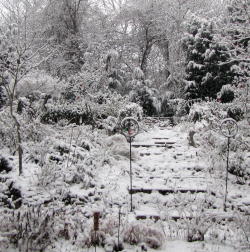
This post will explain how we go about turning the larger type of butterfly bush, Buddleia davidii, not the dwarf or smaller types that are now available, into a standard. By a standard I mean a woody shrub that normally grows with several stems at ground level that has been pruned and trained into a single stem supported by a strong post with branching at a higher level.

There are lots of reasons to do such a thing, including using the space underneath to grow more plants, manage a shrub that can get quite large and unruly in a small garden, it offers a neater appearance, it’s fun to do and the best reason of all, the butterflies!

Right up front I want to mention that often an especially harsh winter, even in USDA Zone 7a southeast Tennessee, will kill the upper parts of Buddleia davidii back to the roots, especially on older standards. But not to worry, for the gardener can start the process all over again with the young shoots that regrow, sometimes, often actually even improving on the shape and size. We don’t always get multiple chances to get pruning right but this dying back can be a blessing as we are continually evolving in skill level with the secaturs. Above is B. ‘Potter’s Purple’ in its fifth incarnation as a standard.

Experience has taught me it is better to begin the branching low enough so that the flower ends are easier to photograph. In the past, photo from August of 2010, the flowers and the flutterbies they attract were sky high!

Choose a young, healthy and vigorous cultivar of butterfly bush. B. ‘Pink Delight’ and B. ‘Potter’s Purple’ are two good selections that have been growing in the Fairegarden as standards for over twelve years now. In some places Buddleia davidii is considered an invasive pest, but in my garden that is not the case. The few unwanted seedlings that have appeared here are easily pulled and composted, but a couple were stuck behind the arborvitae hedge to help hide the brush pile and offer sustenance to critters. The photos illustrating the technique for this post were executed on one of those strays. We have also rooted prunings by simply sticking them in the ground. The opening photo is of a cutting grown standard of B. ‘Potter’s Purple’ flanked by red Asiatic lilies. The above photo is the mother B. ‘Potter’s Purple’ in August of 2010.

Pick a sunny and well drained spot in which to plant a new subject, or use this method on an established bush. I have done it both ways with success. You will need a strong metal stake, rust proof wire and scissors or snips to cut the wire and sharp pruning shears. Don’t dull your good pruners by cutting wire with them!

Let us begin. This is a two year old seedling, one of three planted in a cluster to hide the brush pile at the back of the property. Any of these stems could be used to become the single trunk, but we are going to select the older, more woody one for this purpose. It will be stronger and less likely to break off with the manipulation involved in securing it to the metal stake. All other stems will be cut away below ground level. Vigilence is needed to continue cutting away any stems trying to grow from the roots or along the trunk.

Cut off all of the lower branches flush with the main stem. When there are two or more branches of nearly equal thickness, choose to leave the one that will make the straightest trunk, even if it is not the thickest.

When you get to the topmost growth, you can either allow multiple stems or only have one. More pruning can and will be require over time to achieve and maintain the shape and size that you want.

Insert the metal stake. This is a five foot fence post. A filled out Buddleia in full bloom is heavy, especially when wet. The main trunk can break under the weight, especially in high winds or storms. The prop needs to be up to the task, so please don’t use bamboo or small diameter metal for this job.

Secure the stem to the metal stake with rust proof wire in as many places as needed to straighten the trunk. Be gentle and go slow, you don’t want to damage this stem, it will be the main artery for abundant blooms and foliage growth for several years. Its health and well being are what makes this project successfull, but if it does break, wait a while for new growth and try again later. As with all staking, including dahlias, lilies or whatever, first tie the wire to the stake, give it a couple of twists then tie the branch with a few more twists. Be prepared to check and loosen the latter twists so the metal does not dig into the bark over the years. An inch or two or three for leeway should restrict the movement enough to prevent breakage without cutting into the stem. Pruning is a constant to maintain these and all standards. Buddleia davidii is an excellent choice to be so grown because it blooms on new growth. The more you cut, the more flowers you get. In winter here the stems are cut to about six inches from the branching point.

Soon there will be the visitors we so adore dining from the buffet of standard grown butterfly bushes here. I can barely wait!
****
An earlier post was written about the butterly bush standards in July of 2008 that can be seen by clicking here. As with all of the old posts written on the blogger platform, before the switch to WordPress on September 10, 2008, the photos are small but clickable to enlarge.
For other How To posts written by Fairegarden, look for How To on the sidebar page listing or click here.
Frances









My dear, Thank you for the marvelous how to! This treatment is perfect in a smaller garden space where sun and real estate are at a premium. Love the butterflies happily feasting on the flowers…xoxogail
That’sbeen my complaint about butterfly bushes all along~too rangy. I may have to try this! I saw a garden on Sunday and the gardener and I chatted about the shrubs he pruned~I am inspired by him to chop on my hypericums now. xoxogail
I love all Buddlejas but this way of growing them is new to me.
Interesting approach to take with your buddleia…I can see how it’s a win win (as long as the gardener doesn’t mind the extra work) since it opens up the opportunity for underplanting which means another layer of flowers…yay…the win win part! In going back to read the 2008 post, I am curious to learn what the status is of the curly willows which were on the receiving end of very aggressive pruning. It sounded like you were doing pollarding (if that’s the right word choice?). Do the willow still exist and have you continued keeping their size more minimal?
We have lots of buddleia trees and bushes growing wild where I live. I’m not an expert so I don’t know how many kinds there are but there are two clear colour differences. I think it’s the painted lady butterflies which like them best here. I wish we had monarchs! I’m not sure how long the wild ones last. Their trunks get interestingly brittle and flakey. Do the cultivated ones last longer or do you need to replace them every so often? I’m torn about butterflies. I like to see them – but don’t like the caterpillars which follow. I imagine buddleias are so fast growing and have so many leaves it doesn’t matter how many creatures they support for although many are untidy they don’t seem to get tatty.
Hi Frances…thanks for this great info. I think this is a wonderful idea. I agree, they get so big and rangy and take up too much space. We just removed four of them because they got so big they fell over. I’m going to try this with the two that are remaining!
Thanks for this. I never would have thought you could make a standard where the plant dies to the ground in winter. I certainly like the idea of an anhual do over for my pruning efforts. I only have a compact Buddleia called Adonis Blue I planted just this spring. However, I seem to hear B. davidii calling to me.
Thanks for the great post! I’ve been wary about planting a Buddleja due to their sprawling habit but this is a good option. Now I just have to find the right place for one in a standard form…
Thanks for the info. I didn’t know that could be done.
Interesting, though here in my garden, I would have to start over annually as most of the time Buddleia dies back considerably in the winter. Good point about needing support for the standard part.
I am a timid pruner but I am always inspired by seeing what good and bold pruning can accomplish. I just went on a garden tour and in one big and grand garden there was a huge buddleia alternifolia that was pruned up against an outbuilding. I think it was trained to a standard which created a cascading waterfall of blossoms. It was a pretty impressive sight. Your garden is always and everywhere an impressive sight.
Lovely photos and blog, I actually do this to a lot of shrubs and trees as you say it gives so much more room for planting
Although the green leaves add a welcome bit of color to any landscape, it is the masses of blossoms—long, seductively spiked trusses—that are special. These plants can be an invasive species in some areas.